#cell nuclei
Photo
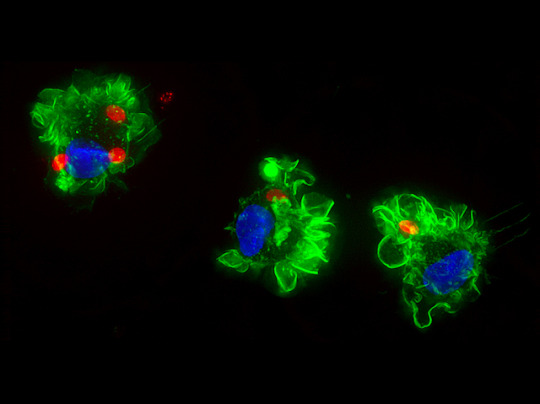
Made to Move
Estimated to infect around 30% of people worldwide, Toxoplasma gondii is a widespread parasite with a peculiar life cycle: it reproduces sexually only in its main hosts, wild and domestic cats, but can also infect and replicate inside other species, including humans. The ensuing disease, toxoplasmosis, can cause flu-like symptoms before settling in as a generally symptomless chronic condition, although it becomes more dangerous during pregnancy and for patients with weakened immunity. Toxoplasma’s superpower is its ability to hijack the immune system, infecting macrophages, which normally gobble up pathogens, then altering their behaviour. Infection with Toxoplasma (pictured, in red), changes gene expression inside macrophages (in green, with nuclei in blue), reprogramming them to become more mobile, so they themselves help to spread the parasites. Recent research revealed that Toxoplasma uses a protein called GRA28 to re-organise DNA in the macrophages’ nuclei, suggesting a new target for scientists investigating potential treatments.
Written by Emmanuelle Briolat
Image from work by Arne L Ten Hoeve and Laurence Braun, and colleagues
Department of Molecular Biosciences, The Wenner-Gren Institute, Stockholm University, Stockholm, Sweden
Image copyright held by the original authors
Research published in Cell Host Microbe, November 2022
You can also follow BPoD on Instagram, Twitter and Facebook
#science#biomedicine#parasite#toxoplasma#toxoplasma gondii#macrophages#cell nuclei#toxoplasmosis#immunofluorescence
13 notes
·
View notes
Text
adventure of the day is attempting to read louvre pottery descriptions using only my very shaky french from school
when it describes depicted figures like "Ulysse avec barbe et épée" i'm like sure, that's odysseus with beard and sword, there he is
i had some more trouble with "Diomède avec chlamyd" but it turns out that diomedes has a chlamys (cloak) and NOT chlamydia
#today i learned chlamydia is named after the chlamys bc apparently it 'cloaks' cell nuclei?? huh#meanwhile greek heroes are reminded to wrap their tools#tagamemnon
3 notes
·
View notes
Photo
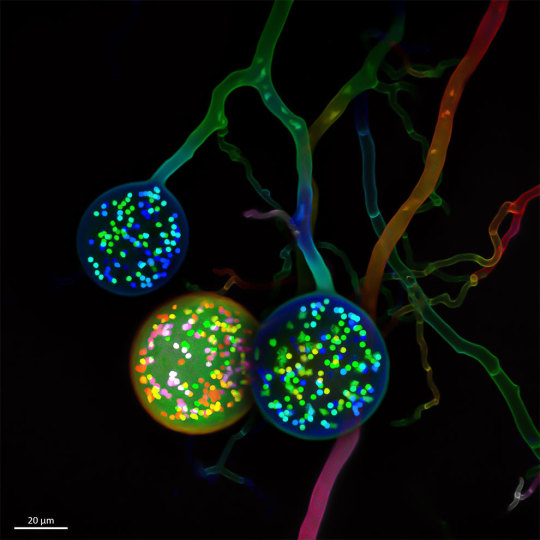
Multinucleate spores of a soil fungus. One cell typically carries one nucleus. In contrast, as seen here, an arbuscular mycorrhizal (AM) fungal cell carries hundreds of nuclei.
By Vasilis Kokkoris (Netherlands)
Olympus Image Of The Year Award
#vasilis kokkoris#photographer#netherlands#olympus image of the year award#multinucleate spors#soil fungus#nucleus#arbuscular mycorrhizal (am) fungal cell#nuclei#nature#micro photography
26 notes
·
View notes
Note
this is just kinda random and speculative
but couldn't iterators be thought of as like. giant circulatory systems?
neurons being the 'red blood cells' (though most likely transmitting data instead of oxygen). combination actual neurons and data storage and transmitter all at the same time. also I like to think of neurons as big unicellular organisms.
inspectors being 'white blood cells' and murdering anything that moves weirdly
youve probably thought of all of this before I'm just rambling a bit dont mind me
the whole is a giant brain (built to think) but i like this comparison a lot
i haven't explored the ingame iterators in a hot second but imagining neurons + inspectors everywhere in a sort of open circulatory system. stuff comes and goes wherever and isn't confined to vessels
the implied water circulatory is interesting too. downpour devs interpreted moon's death as iterator equivalent of a heart attack but the water system also makes me think of lymph. flushing out waste, delivering vital cooling (in our body its nutrients [lipids] and water recycling) properties at a slower pace (cycles are ~ a day in my theories because cycles end at night in dp)
#asks.txt#ardienothesieno#neurons as unicellular is real though#some alage get crazy big for being literally ONE CELL with MANY NUCLEI
4 notes
·
View notes
Photo

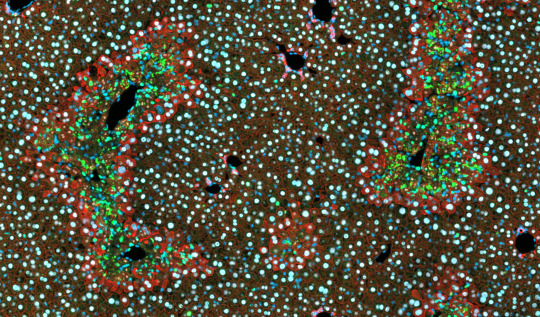
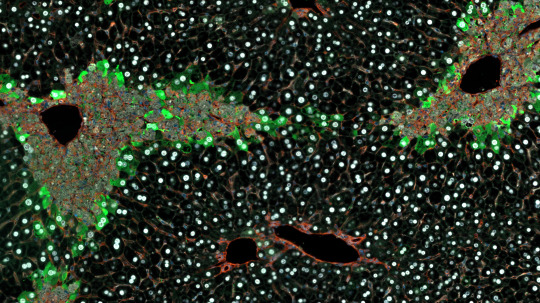
no art but you know what. everyone look at and enjoy a little of my immunohistochemistry staining<3
#the first one looks the coolest bc its a very badly off human liver that was trying soo hard to repair itself#like the big white dots are nuclei of healthy liver cells. everything else is necrotic#idk why im even posting this. just look at my scients:)
29 notes
·
View notes
Text
The fun thing about my job is that sometimes my project sounds entirely fake. I spent hours today working on a concept called pseudotime- who am I, the Doctor?
#doctor who#dw#neuroscience#for anyone interested pseudotime is a way of plotting developmental trajectories in a single cell/nuclei sequencing context#i also made it work for the first time today after several weeks#wibbly wobbly timey wimey
2 notes
·
View notes
Text
Entire World stop acting like people’s food tastes are a choice challenge
#imminent stabbing#i am arming each of my blood cells and nuclei with tiny knives#homicide murder slaughter killing massacre you’re SO annoying about this it’s actually insane#why do you even CARE what people do or do not eat#y’all all like ‘boo ableism is yucky hashtag intersectionality !! also HAHA childish loser won’t eat veggies lol lmao lol lol’#you think i should eat veg i think you should eat radioactive drill bits
2 notes
·
View notes
Text
Lightning, camera, gamma ray! - Technology Org
New Post has been published on https://thedigitalinsider.com/lightning-camera-gamma-ray-technology-org/
Lightning, camera, gamma ray! - Technology Org
In September 2021, an unprecedented thunderstorm blew across Utah’s West Desert. Lightning from this storm produced at least six gamma-ray flashes that beamed downward to Earth’s surface and activated detectors at the University of Utah-led Telescope Array. The storm was noteworthy on its own—the array usually clocks one or two of the lightning-triggered gamma rays per year—but recent upgrades led to a new observation by the Telescope Array scientists and their lightning collaborators.
Lightning captured with the highspeed camera at 40,000 frames per second. Image credit: Rasha Abbasi
For the first time ever, they captured video footage of lightning-triggered downward terrestrial gamma-ray flashes (TGFs). A special camera running at 40,000 frames per second gave an unprecedented look at how gamma rays burst downwards to the Earth’s surface from cloud-to-ground lightning strikes. They found that not only were multiple gamma rays produced at later lightning stages than previously thought, but the rays were also associated with a pulse of optical light that had never been recorded.
“This is an important step in lightning research that could lead us to the physics producing these downward gamma rays,” said lead author Dr. Rasha Abbasi, now an assistant professor of physics at Loyola University Chicago. Abbasi began the research on TGFs as a postdoctoral scholar at the University of Utah.
The study published in Geophysical Review Letters.
Telescope Array Collaborative leads the field
Gamma rays are no joke. The highest-energy light waves on the electromagnetic spectrum can knock electrons off atoms and cause serious harm to human cells. Until BATSE satellite detected the first terrestrial gamma ray flash in 1994, scientists thought only galactic events like exploding stars could produce gamma rays. Over time, physicists determined that TGFs were produced in the initial milliseconds of upward intracloud lightning, which beamed the rays into space. Since discovering upward TGFs, researchers have sought to understand the rarer phenomenon of downward TGFs, when cloud-to-ground lightning produces gamma rays that beam to the Earth’s surface.
Ground-based observations are ideal for studying downward TGFs because they’re just a few kilometers from the lightning storms themselves.
“The ability of the Telescope Array Surface Detector to detect downward TGFs is a great example of serendipity in science,” said John Belz, professor of physics and astronomy at the U and co-author of the study. “The TASD was designed to do astroparticle physics, by studying the particle showers produced by energetic atomic nuclei from deep space. Purely by happenchance, the astroparticle showers share many properties—including energy, duration, and size—with the gamma ray showers known as downward TGFs. So in a sense, we are able to operate two groundbreaking science facilities for the price of one.”
Telescope Array collaborators from the University of Utah, Loyola University Chicago, the Langmuir Laboratory for Atmospheric Research at New Mexico Tech and the National Institute for Space Research-Brazil (INPE), have installed a suite of lighting instrumentation to the existing Telescope Array, a ground-based grid of surface detectors primarily designed to observe ultra-high energy cosmic rays.
The stages of lighting that triggered terrestrial gamma rays. Image credit: Abbasi et al., 2023.
The array covers an area the size of New York City and is the largest of its kind in the northern hemisphere. The groups have added a lightning mapping array, a broadband very high-speed interferometer, a fast antenna that measures the electric field change over the lightning flash, and most recently, multiple high-speed video cameras.
“In one second, your eye sees a lightning flash—that’s it. These instruments measure the change in the electric field over the whole lightning flash that happens in the blink of an eye,” said Abbasi. “We’re interested in the science of the gamma ray initiation. What stage of the lightning produces the gamma ray? Why do gamma rays happen in correlation with some lightning flashes, but they don’t in others?”
The efforts have paid off. The study analyzed one of these TGF events. They identified that the cloud-to-ground flash with the observed TGF was formed by lightning’s fast downward leader, followed by an intense return stroke. The TGF occurred while the downward leader was already branching well below the cloud base, even halfway in its propagation to the ground.
“This new finding is a consequence of collaborations between astroparticle physicists and lightning scientists,“ said Marcelo Saba, co-author at the INPE. “It is exciting to merge efforts together.”
What’s next?
Telescope Array’s massive footprint is large enough to detect particle showers as they rain down across a wide area of Earth’s surface. Its 500-plus surface detector stations cover 700 km2 (~270 miles2) outside of Delta, Utah, in the southwestern part of the state. It’s in the process of expanding to four times its original size. The researchers expect that the expansion, in addition to recently installed lightning sensors, will unlock new discoveries.
“For example, do downward-TGFs and upward-TGFs represent different manifestations of the same phenomenon and share a common origin? Is it possible to achieve simultaneous detection of upward and downward TGFs? Under what meteorological conditions do thunderstorms produce TGFs? What are the underlying physical mechanisms connecting multiple lightning stages to TGF initiation?” asked Abbasi. “We hope to detect more events to address these questions still left unanswered.”
Source: University of Utah
You can offer your link to a page which is relevant to the topic of this post.
#000#2023#Astronomy#atomic#atomic nuclei#atoms#Brazil#Cameras#Cells#change#Cloud#collaborative#cosmic rays#detection#Discoveries#earth#electric field#electromagnetic#electromagnetic spectrum#electrons#energy#Events#eye#Facilities#Featured physics news#flash#Fundamental physics news#Gamma rays#grid#hemisphere
0 notes
Text
Wasps so tiny you will question everything.
Imagine being so teeny tiny that you are an endoparasite on *leafhoppers* Leafhoppers are already in the "so small they go unnoticed" category, and you're just a little pest on a minuscule thing.
Of course the group that's most likely to choose this life? The wasps Wasps are some of the smallest insects. There are "fairy flies" that are parasites of the eggs of certain insects.
They are so small that air is "thick" to them and their wings have feathered edges are are oar shaped.
Some fairly flies are so tiny that their neurons are cells without nuclei. They got rid of them to save space. They can still think though... presumably the tiniest little thoughts.
Photo by Alexey Polilov, 2012
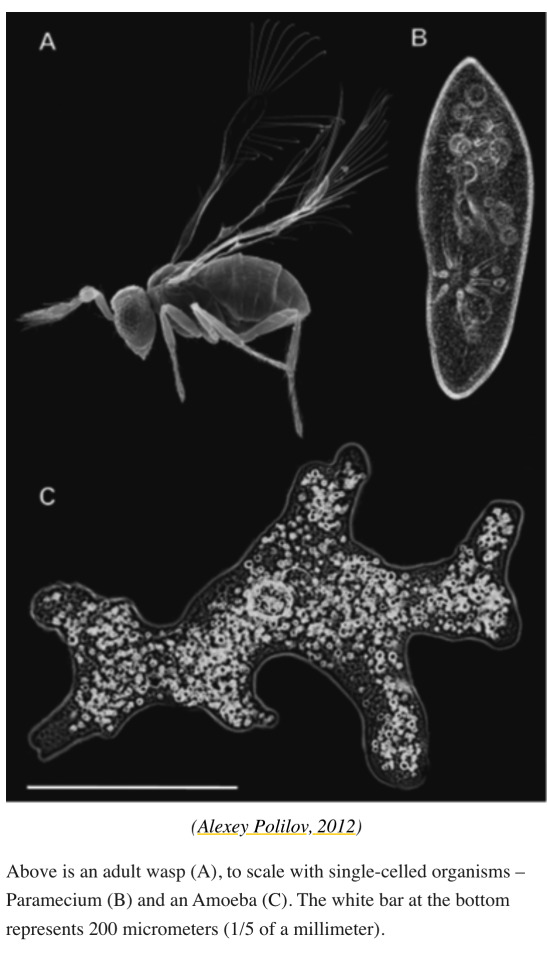
They lay their eggs inside of the eggs of 1-2mm long crop pests.
And... read the article to see what the males are like... they are even smaller somehow, but it's ... disturbing.
#tiny#too tiny#so smol#smol#hymenoptera#wasp#wasps#fairycore#fairy flies#Megaphragma mymaripenne#Megaphragma#little#bug#bugblr#cute bugs#arthropods#insects#invertebrates
6K notes
·
View notes
Text
At maturity, the Polygonum-type embryo sac consists of seven cells and eight nuclei.
"Plant Physiology and Development" int'l 6e - Taiz, L., Zeiger, E., Møller, I.M., Murphy, A.
#book quote#plant physiology and development#nonfiction#textbook#maturity#polygonum#embryo sac#plant cells#nuclei#plant reproduction
0 notes
Text
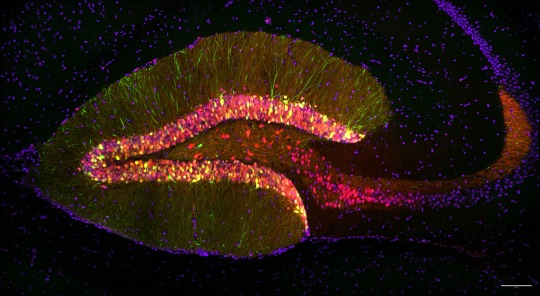
I did craniotomies to microinject two fluorescent viruses into the hippocampus of some mice and sewed em back up and let em chill for 2-3 weeks and then took these pics of their brain….i could look at this shi for hours😭😭
(Taken on a Nikon confocal microscope at 40x objective)
1 note
·
View note
Note
what do you mean the centaurs aren’t eukaryotes???
do their cells really not have nuclei???
You misunderstand, they are not eukaryotes because "eukaryote" is a taxonomic category describing a clade of life on Earth. They are eukaryote-like in the same way they are mammal-like. Their cells could be physiologically described as having endosymbiotic plastids.
For the other people who asked, no, I couldn't really describe the differences in their cells from ours for the same reason I've avoided describing alien biochemistry. I'm more interested in describing morphology, and I know enough about biochem to know I don't know anything about it.
#jaytext#i get lost in details so much with worldbuilding that if i dont draw a hard line on what i plan to describe and what i plan to handwave#i would never get anything done#runaway to the stars
508 notes
·
View notes
Text
Time for another appreciation post for sarcomas because I came across a mother of one the other day:

1 - a relatively normal cancer cell with a prominent nucleolus (dark dot in the middle of the slightly lighter oval)
2 - a cancer cell showing an increased cell size and a large nucleolus
3 - a cancer cell who decided to become a beast with significant karyomegaly and a huge nucleolus
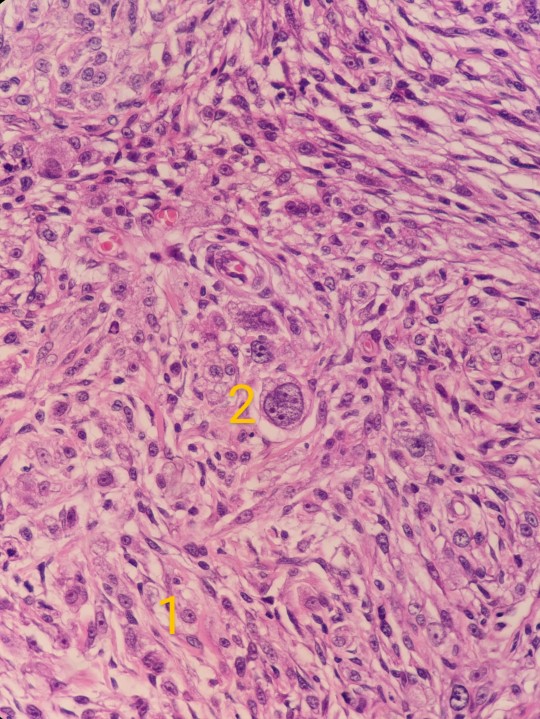
1 - a relatively normal cancer cell
2 - a super large beast with four nucleoli
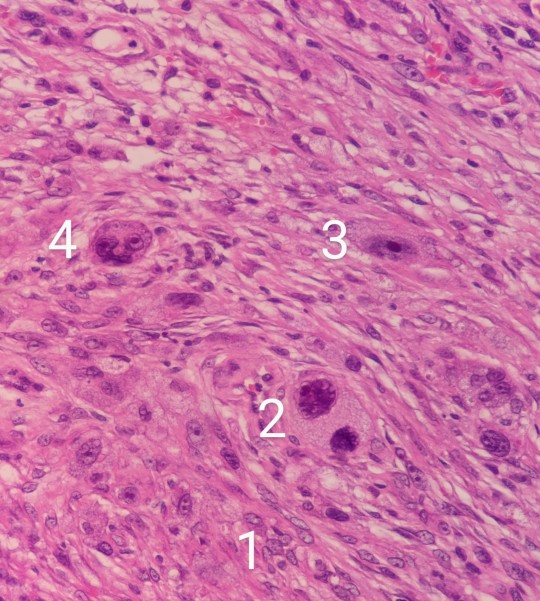
1 - a normal sized cancer cell
2 - a cancer cell with two large nuclei of varying sizes (so a binucleated cell with karyomegaly)
3 - a cancer cell with karyomegaly and a large nucleolus
4 - me on an average monday
125 notes
·
View notes
Photo

Semi-separated nuclei of two cells form a heart-to-heart shape. The nuclei were labeled by lamin.
By Di Lu (China)
Olympus Image Of The Year Award
#di lu#photographer#china#olympus image of the year award#micro photography#semi-separated nuclei#heart-to-heart shape#nuclei#lamin#nature
3K notes
·
View notes
Text

#if only there weren’t seven gazillion pop-ups filling my screen jeff#*jfc#JEFF??#blaming the ads on jeff now. fuck you jeff#doctor who#tardis wiki#id in alt text
182 notes
·
View notes
Text



Origins : Complexity Rising
18 x 24 inches, Oil on Panel, A new painting from an earlier study.
We tend to think of evolution as a biological process of rising complexity that began with single-celled organisms here on earth, but the universe has been undergoing a cosmic evolution of growing complexity from the very beginning.
Before there could be cells, there needed to be complex molecules and an array of elements to make them. The earliest known events of the universe generated only a few of the lightest elements: hydrogen, helium, and trace amounts of lithium. Until the first stars formed and began fusing protons and neutrons into larger nuclei the universe was devoid of heavier elements, including the carbon, nitrogen, and oxygen of which we are made. Other processes took these elements and bonded them into basic amino acids and other molecular building blocks of life as we know it.
Biological evolution on our planet is thought to be nearly as old as the Earth, but the complexity that made it possible has been accumulating since time began.
_______
In this painting, the thread of gas and dust that grows from the left and reaches a crescendo at the right represents the growth of complexity through time. Also featured is a developing galaxy, early massive hot blue stars fusing higher elements, a supernova explosion spreading higher elements into space, a new star and protoplanetary disk enriched with elements, and a newly formed earth-like planet in the bottom right. The figure, an allegory of rising complexity, wears a necklace featuring a carbon atom and her hairpiece is a model of a basic amino acid that has been found abundantly in outer space. These are the building blocks of life ready for biological evolution to begin!
193 notes
·
View notes